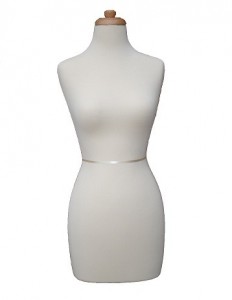 By Jae-Ha Kim
By Jae-Ha Kim
Chicago Sun-Times
May 30, 2001
When is a perfect size 6 not so perfect? When it’s really a size 8. Confused? Join the club.
If you’re a woman–or you’ve ever tried shopping for your favorite femme–you already know that judging fit by eyeballing the item or checking the tag is a crapshoot. A size 6 Donna Karan skirt may fit like a charm. But if you try that same size in something like Guess? or BCBG, you may wonder when you managed to pack on an extra five pounds.
Think about the last time you walked into a dressing room with a particular size in mind that fit just right. Jenny Andres can’t recall, either.
“If you asked me what size I am, I’d have to say that I have no idea what the hell it is,” says Andres. “I stay the same size, but the sizes on the clothes never stay the same. It seems like designers are more interested in selling women on an idea of their size rather than fitting us with appropriate clothes.
“It’s completely insane. Do they think women are so vain that we won’t buy clothes if they’re not the ‘right’ size? I find the whole thing to be really manipulative.”
Broad shouldered and slender, the 5-foot 10-inch Lake View resident has learned that in order to find clothes that fit her, she has to weed through racks of clothes and try on everything from juniors size 7 to a womanly size 12.
“I don’t know why the [fashion industry] just won’t standardize sizes,” she says. “That would make things so much easier for everyone. Granted, not everything is going to fit perfectly. I know that’s impossible But it’ll make things so much better for women to know that a size 10 is a size 10 no matter what designer they choose to go with.”
Women’s sizing popped up in the late 19th century when manufacturers began mass producing ready-to-wear clothes. There was no shame in being a size 14 then because all it meant was that you had the figure of a 14-year-old girl.
Literally.
“Sizes were based on age and ran from 14 through 20,” says Linda Jo Connell, associate professor of consumer affairs at Auburn University. “Even then, clothes were fit with younger figures in mind. The problem there was that not every 14-year-old girl had the same figure, so in a way the sizing actually meant nothing. You still had to try it on to see if it would fit.”
An obvious no brainer would be to include measurements with the sizing. But Connell says that leads to other problems.
“Research shows that consumers have asked for that, especially in women’s wear,” says Connell. “But manufacturers are very guarded. If their fit is good, they don’t want it to be copied. It’s an issue of fit as a commodity and selling tool, so they want to guard their specifications.”
Sure, it’d be great if designers would standardize, but there’s no law governing them to do so. While men’s clothes are sold by standard chest and waist measurements, women’s clothes generally are sold by numbers that vary by manufacturer.
Plus, every designer has a different clientele in mind, exacerbating the fluctuating sizes. With no standard to conform to, clothing manufacturers can base sizes on any measurements they wish.
“[Reginalds’] clothes are cut more generous today than five years ago because the average female is larger now,” says Chicago designer Reginald Thomas of Reginalds “It would be nice to have a uniform sizing for all clothes, but it would be very difficult. Fashion is global and we’d have to get together with the world to coordinate fashion sizes. How would we do that? The European and Asian markets cut their clothes way smaller than Americans because they’re smaller than us.
“Sizing is a gauge and maybe shouldn’t matter as much as it does. But I have found that some women are very concerned with size. Sometimes we don’t even put sizes on our clothes for our private clients.”
Interesting concept, but that obviously wouldn’t work in mass retail.
American women tend to be larger than previous generations, so a certain tweaking of sizes is understandable. Besides being fatter from a diet of fast food and inactivity, women are taller and have broader shoulders. Plus, we don’t shoehorn ourselves into constricting undergarments (girdle or corset, anyone? I think not!) anymore.
“Standardized sizing has been talked about, but the apparel industry is a consumer-driven business,” says Jack Morgan of the American Apparel & Footwear Association. “The reality that we see is that most consumers would rather have style and fashion over uniformity. There was a time in the 1940’s when there was a uniform standard. The U.S. Army conducted a study of body types for men and women to supply uniforms for the war. This system gradually broke down as individual companies and designers sought to sell clothes to their visions of the ideal customer.”
Still, the ideal and reality often don’t conform, which may explain why industry estimates show that merchandise returns due to poor fit cost retailers about $28 billion per year.
“People will buy clothes they think they should be able to fit into and find that they can’t,” says Morgan. “I’m sure that this was contributed to the phenomenon of vanity sizing [of larger clothes being designated as a size or two smaller]. This isn’t that surprising considering the climate that we live in. We live in a culture that values thinness. There are consumers out there who do get concerned if they think they’re supposed to be a size 8 and find out that they aren’t anymore. And some designers are catering to that.”
With the likelihood of standardized sizing occurring around the time that America embraces the metric system–i.e. never!–what’s a woman to do besides trying on racks of pants to find that perfect fit?
“We firmly believe that technology is going to provide better options to find clothes that look good and fit well,” says Morgan. “More stores are investing in systems that will ‘scan’ your body so that manufacturers can customize your clothing so that it fits.”
It’ll be a while, though. The Levi’s store in San Francisco is set up to scan in your measurements to create custom-fitting jeans that’ll hug your booty, but the rest of the branches–including the Levi’s boutique on Michigan Avenue–still are old school. They use tape measurers.
“One way to alleviate some of the stress of clothes shopping is sticking to designers that appear to be true to size,” says Andres. “That may mean that I won’t try as many different designers, but at least I won’t leave the store as aggravated as I used to.”
***
“I’ve always thought Marilyn Monroe looked fabulous, but I’d kill myself if I was that fat. I went to see her clothes in the exhibition, and I wanted to take a tape measure and measure what her hips were. She was very big.”
— Elizabeth Hurley in Allure magazine
Note to Hurley: Get a clue. At her heaviest Monroe wore a size 16, which would roughly translate into a modern-day size 8 or 10–not that much larger than Hurley’s dress size.
***
• Own a size 8 dress today? Don’t be so smug. A decade ago, that same dress would’ve been sold as a size 10.
• Ever wonder why you’re a size 8 but can’t manage to squeeze into your mother’s vintage size 10 skirt? That’s ’cause a size 10 from 1942 is equivalent to a size 2 today.
• Sixty years ago, the average American’s bottom was 2 inches smaller than today’s 16 inches.
• Most toilet seats are 14.5 inches wide.
• One-third of America’s women can’t buy bikini brief undies at Victoria’s Secret. Vicky’s doesn’t offer size X-Large (which fits 16-18) in bikini form. Good news though: High-end lingerie designer La Perla is prepping a line for women size 14 and up.
Source: Marie Claire





